Abstract
Background and study aims: The proportion of outpatients with inadequate bowel preparation before colonoscopy is high owing to patient unawareness of its importance and poor adherence to instructions. This meta-analysis aimed to determine the effect of educational intervention on the quality of bowel preparation before colonoscopy.
Patients and methods: A comprehensive literature review identified randomized controlled trials measuring the effect of educational intervention on the quality of bowel preparation. Two reviewers independently screened relevant articles, extracted data, and assessed the risk of bias. The primary outcome was the quality of each bowel preparation before colonoscopy, using a particular assessment scale. The secondary outcomes were polyp detection rates during the procedure and the need for a repeat colonoscopy due to incomplete examination.
Results: Nine randomized controlled trials were included in this meta-analysis. In all, 2885 patients were enrolled, with 1458 receiving education and 1427 assigned to the control group. An educational intervention before colonoscopy significantly improved bowel preparation (relative risk [RR] = 1.22; 95 % confidence interval [CI], 1.10 – 1.36), however, no significant differences were identified in polyp detection rates (RR = 1.14; 95 %CI 0.87 – 1.51) or the need for repeat colonoscopy (RR = 0.52; 95 %CI 0.25 – 1.04) between the groups. Asymmetry in the appearance of the funnel plot and the result of Egger test (P < 0.001) suggested that publication bias existed.
Conclusions: Evidence from these randomized controlled trials shows that a brief counseling session with patients before colonoscopy ensures better bowel preparation. However, evidence is insufficient to assess improvements in polyp detection rate and avoidance of a repeat colonoscopy. Despite these encouraging observations, this meta-analysis had some limitations, including potential publication bias and significant heterogeneity of the types of bowel purgatives. These results should be interpreted with caution.
Introduction
Colonoscopy is a useful and widely available tool for diagnosing and managing colorectal diseases. It has high sensitivity and specificity for detecting colonic diseases, and it allows tissue sampling for pathological diagnosis and therapeutic procedures 1. According to the United States’ National Polyp Study, colonoscopy can reduce the incidence and associated mortality of colorectal cancer (CRC), and polypectomy can lower CRC death rates if polyps are detected during colonoscopy 2 3.
For adequate bowel preparation, patients must follow a restricted diet of clear liquid for 1 to 2 days and consume an unpleasant-tasting purgative to induce diarrhea, which is often accompanied by abdominal discomfort and interruption in daily routine. Considering the preparation method, inadequate bowel preparation is not uncommon. However, the effectiveness of bowel preparation is closely linked to patient compliance and the subsequent result of CRC screening 4. Poor bowel preparation can result in missed colonic neoplasms, a difficult and time-consuming colonoscopy, and an increased risk of complications. Sometimes, a repeat procedure is needed 5. Inadequate preparation for colonoscopy is seen in approximately 10 % to 20 % of patients, and 12 % to 22 % of excess costs are due to inadequate bowel preparation 6 7 8. Previous research has evaluated interventions such as strict dietary restrictions, methods of purgative administration (e. g., single dose vs. split dose), time intervals between bowel preparation and start of colonoscopy, and appointment waiting time, but there is little information outlining the effect of patient education on quality of bowel preparation 9 10 11. This report therefore aims to elucidate the effect of patient education on bowel preparation quality and the impact on polyp detection rates and need for repeat colonoscopy due to incomplete examination.
Patients and methods
Study identification and eligibility criteria
A comprehensive research protocol was planned in line with the Cochrane guidelines and agreed upon by all authors 12. Studies were included if they were (1) randomized controlled trials (RCTs); (2) published in a peer-reviewed journal or a major meeting; (3) included patients undergoing diagnostic or screening colonoscopy; (4) had two treatment arms with a control, using an interventional patient education program; and (5) measured outcome of efficacy using a certain assessment scale. When multiple articles published by the same team from the same institute within the same study interval were identified, only the latest or the most detailed and informative article, or the one with the best-quality methodology, was included. Commentaries, case reports, reviews, and guidelines were excluded.
Information sources
The following six databases were searched for relevant RCTs, without language restrictions, from their inceptions through January 2014: PubMed, EMBASE.com, Cochrane CENTRAL, CINAHL, PsychINFO, and WHO ICTRP. We also established e-mail alerts to identify newly released studies from the databases. A similar search was also carried out to identify previously published systematic reviews, meta-analyses, or both. Search strategies based on the PubMed search strategy were properly revised for the remaining databases, reflecting their specific syntax and controlled vocabularies. Keywords used in the searches included controlled vocabulary (e. g., the United States National Library of Medicine Medical Subject Headings [MeSH]) and text words, including the following: Colonoscopy [MeSH], colonoscop*, colonscop*, colon, colonic, bowel, intestine*; Cathartics [MeSH], prepar*, prep, cleansing, cathartic*; Counseling [MeSH], Patient Education as Topic [MeSH], Teaching Materials [MeSH], instruct*, educate*, education*, reeducat*, re-educat*, teach*, counsel*.
Data extraction
In this systematic review, we followed a Preferred Reporting Items for Systematic Reviews and Meta-Analyses (PRISMA)-compliant methodology 13. Two reviewers extracted data independently and reached a consensus on all components. Data were extracted using the following: first author, year of publication, country of origin, number of patients, and educational material and methods. The primary outcome was the rate of adequate bowel preparation. The secondary outcomes were polyp detection rate during the procedure and the need for repeat colonoscopy due to incomplete examination. Studies included in the analysis were grouped according to investigation and treatment comparisons. Subgroups used were (1) education delivery (indirect: self-education by patients, or direct: instructions given by professionals), (2) educational tools, and (3) language barrier (single language usage vs. multiple language usage because patients required interpretation). The quality of all studies was assessed with the five-point Jadad scale for assessing RCTs 14. Studies with three or more points were considered high quality.
Statistical and publication bias analyses
For each study, data were extracted from descriptions of the endoscopic categorical assessment of the adequacy or inadequacy of preparation. For summary statistics in meta-analyses, relative risk (RR) is recommended for dichotomous data. Pooled estimates were presented with a 95 % confidence interval (CI). The I2 test was used to evaluate potential heterogeneity between studies. The output figure contains effect estimates (RRs), 95 % CIs, and weights for each study, followed by the overall (combined) effect estimate. If the I2 test showed < 50 % heterogeneity, which indicates no significant heterogeneity, the fixed-effects model was used. If the I2 test showed > 50 % heterogeneity, which indicates significant heterogeneity, the random-effects model was used. We used Egger test and funnel plot to quantify the potential presence of publication bias. The STATA (version 12.0) software was used for meta-analysis.
Results
Study selection
The flowchart of study selection is shown in Fig. 1. The search of the six databases identified 385 potentially relevant articles, 85 of which were duplicates. In all, 300 records were screened by title and abstract, 264 of which were irrelevant. A total of 36 full-text articles were assessed for eligibility; 19 did not have matching full-text, included inpatients, or were not RCTs. Fourteen unique studies were identified from 17 articles and reports. Eight articles and reports were not included in the meta-analysis: four were redundant, two did not report percentage of adequate preparation, and two had no control arm or more than two study arms. Finally, nine studies were included in the meta-analysis 6 15 16 17 18 19 20 21 22.
Fig. 1.
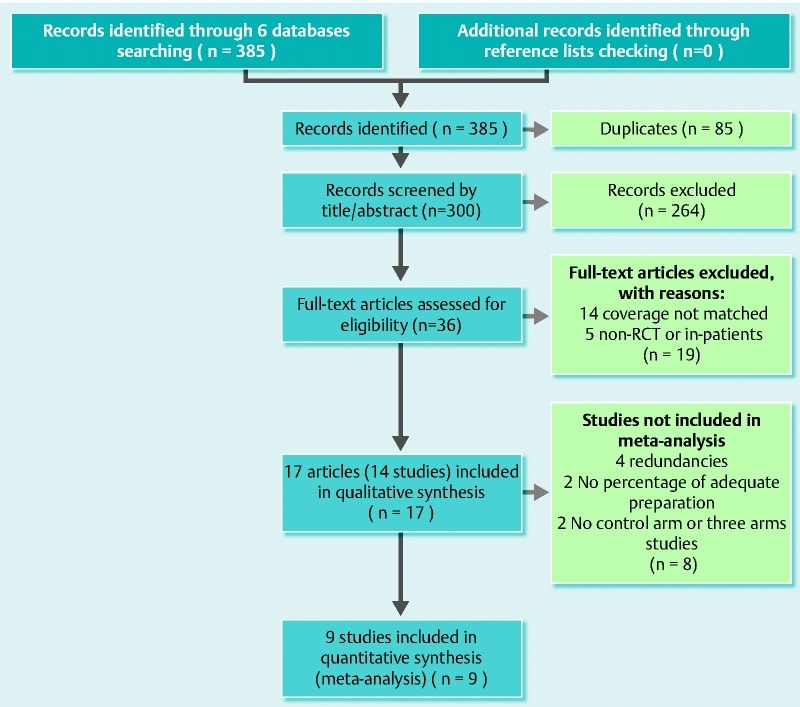
Flowchart of study selection based on PRISMA Statement.
Study characteristics and quality assessment
Assessment of the quality of the studies revealed a score of five for five studies on the Jadad scale, and a score of three for the other four studies. After pooling the studies, 2885 patients were enrolled, with 1458 patients in the educational group and 1427 patients in the control group. Regarding methods of educational delivery, indirect methods were used in five studies, such as mail or telephone message, and a direct method with a specifically assigned individual (i. e., a face-to-face interview with patients) was used in the other four studies. Regarding methods of education, patients were educated with educational tools such as questionnaires, pamphlets, visual aids, cards, booklets, and videos in seven studies, and with mobile phone messages and via telephone in the other two studies. In addition, four studies were performed in Asian countries and the other five studies were performed in Western countries. In the estimation of the methods, five studies used Ottawa scores and four studies used the Boston Bowel Preparation Scale or other methods for evaluating the adequacy of bowel preparation (Table 1).
Table 1. Characteristics and quality assessment of the systemic review and meta-analysis.
| Authors | Year | Ref. | Interval | No. of patients (Edu/Con) | Adequate preparation (Edu/Con) | Delivery methods | Educational tools* | Language | Scales | Jadad scale |
| Liu | 2013 | 15 | 1 day | 305/300 | 81.6 %/70.3 % | Telephone | No | Chinese | Ottawa scores | 5 |
| Park | 2013 | 16 | 6 hr | 136/135 | 53 %/31 % | Mobile phone message | No | Korean | Ottawa scores | 3 |
| Pillai | 2013 | 17 | < 30 days | 56/48 | 79.4 %/57.8 % | Investigator | Yes (Video) |
English | Ottawa scores | 3 |
| Tae | 2012 | 18 | – | 102 /98 | 93.1 %/81.6 % | Health examination center staff | Yes (visual aids) |
Korean/English | BBPS | 5 |
| Calderwood | 2011 | 6 | – | 492/477 | 91 %/89 % | Mail to patient | Yes (visual aids) |
English/others | BBPS | 5 |
| Spiegel | 2011 | 19 | 1 week | 132 /134 | 76 %/46 % | Mail to patient | Yes (booklet) |
English | Ottawa scores | 5 |
| Ahn | 2011 | 20 | – | 100/100 | 80 %/65 % | Investigator | Yes (card) |
Korean | Ottawa scores | 3 |
| Shaikh | 2010 | 21 | 3 weeks | 51/55 | 88.2 %/63.6 % | Mail to patient | Yes (pamphlet) |
English/Spanish | Physician evaluation | 5 |
| Modi | 2009 | 22 | 3 weeks | 84/80 | 56 %/44 % | GI fellows | Yes (questionnaire) | English/others | UPAS | 3 |
BBPS, Boston bowel preparation scale; UPAS, universal preparation assessment scale
BBPS: Boston Bowel Preparation Scale
Liu et al used telephone re-education and Park et al used mobile phone message without instruments.
Effect of patient education on adequate bowel preparation
The incidence of adequate bowel preparation ranged from 53 % to 93 % in the education group and from 31 % to 89 % in the control group ( Table 1). The I2 test from these studies showed > 50 % heterogeneity, which indicates significant heterogeneity, and the random-effects model was used. In Fig. 2, forest plots display an inverse-variance weighted random-effects meta-analysis of the effect of education on adequate bowel preparation. Patient education before colonoscopy can result in significantly improved quality of bowel preparation (RR = 1.22; 95 %CI 1.10 – 1.36). Results are stratified by delivery methods, educational tools, and country. The overall random-effects estimate is also displayed.
Fig. 2.
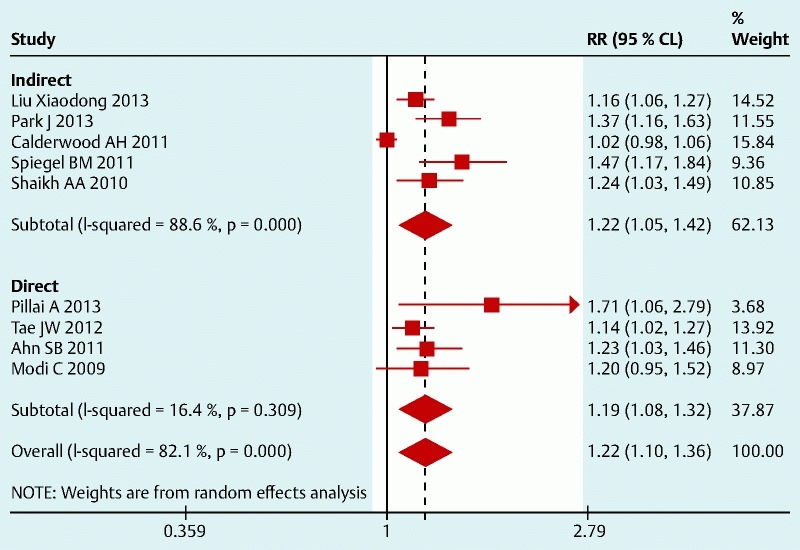
Forest plots display an inverse-variance weighted random-effects meta-analysis of the effect of education on adequate bowel preparation and in the subgroup analysis based on education delivery method for patients who learned by themselves versus for whom education was provided by professionals.
In the subgroup analysis based on education delivery method, patients learned by themselves (indirect method) in five studies (RR = 1.22; 95 %CI 1.05 – 1.42), and education was provided by professionals (direct method) in four studies (RR = 1.19; 95 % CI 1.08 – 1.32), both of which improved the quality of bowel preparation (Fig. 2). In the subgroup analysis based on the use of educational tools, tools were used in seven studies (RR = 1.21; 95 %CI 1.06 – 1.38) but not in two studies (RR = 1.24; 95 %CI 1.06 – 1.47); both methods had an effect on bowel preparation (Fig. 3). In the subgroup analysis based on geographically different education delivery, the quality of bowel preparation significantly improved after patient education in the four Asian studies (RR = 1.20; 95 %CI 1.11 – 1.29) as well as the five Western studies (RR = 1.26; 95 % CI 1.01 – 1.55) (Fig. 4). Asymmetry in the appearance of the funnel plot and the result of Egger test (P < 0.001) suggested that publication bias existed (Fig. 5).
Fig. 3.
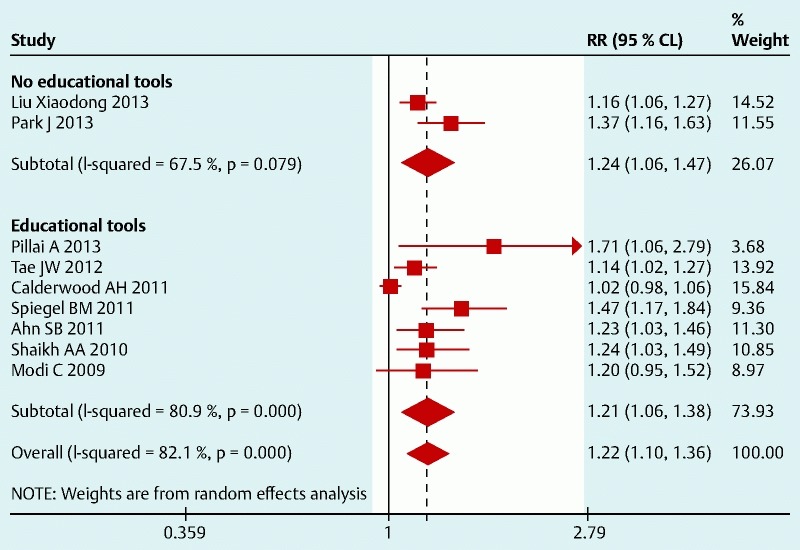
Forest plots display an inverse-variance weighted random-effects meta-analysis of the effect of education on adequate bowel preparation and in the subgroup analysis for use of educational tools versus no use of educational tools.
Fig.4.
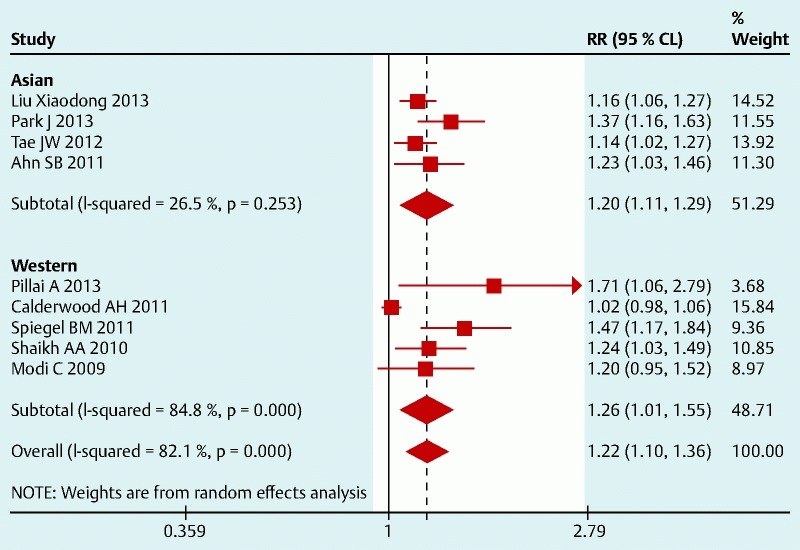
Forest plots display an inverse-variance weighted random-effects meta-analysis of the effect of education on adequate bowel preparation and in the subgroup analysis based on geographically differences between Asian and Western studies.
Fig. 5.
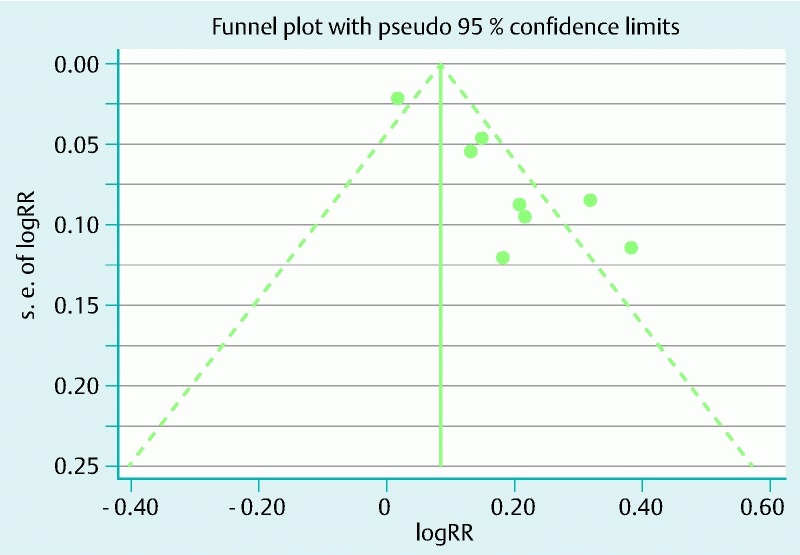
Asymmetry in the appearance of the funnel plot and the result of Egger test (P < 0.001) suggested the existence of publication bias.
Effect of patient education on polyp detection rate
In the current analysis, only three studies discussed the effects of patient education on polyp detection. Heterogeneity between subgroups was found (I2 = 78.9 %; P = 0.009), and the random-effects model showed no significant difference in the polyp detection rate between the education group and the control group, according to our analysis (RR = 1.14; 95 %CI 0.87 – 1.51) ( Fig. 6).
Fig. 6.

Forest plots display an inverse-variance weighted random-effects meta-analysis of the effect of education on the polyp detection rate for the education group versus the control group.
Effect of patient education on the need for repeat colonoscopy owing to incomplete examination
Four studies discussed the need for repeat colonoscopy owing to an incomplete first colonoscopy. Heterogeneity between subgroups was found (I2 = 77.8 %; P = 0.004), and the random-effects model showed only a marginal decrease in frequency of repeat colonoscopy in the education group. It did not reach statistical significance (RR = 0.52; 95 %CI 0.25 – 1.04) ( Fig. 7).
Fig. 7.
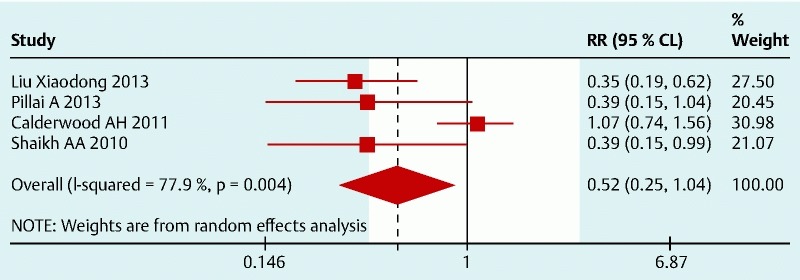
Forest plots display an inverse-variance weighted random-effects meta-analysis of the effect of education on the rate of repeat colonoscopy in the education group versus the control group.
Discussion
For complete evaluation of the colon during colonoscopy, adequate bowel preparation is necessary. An effective intervention to improve the quality of bowel preparation could have important clinical and economic benefits. 23 To improve preparation quality, many studies have discussed the contents of purgatives (e. g., polyethylene glycol solution vs. sodium phosphate plus magnesium citrate), timing of consumption (e. g., same day vs. previous day), and method of administration (e. g., single dose vs. split dose) 19 24 25 26 27. However, little information is available regarding the effect of patient education on the quality of bowel preparation. The purpose of this meta-analysis was to determine the effect of enhanced patient education on the quality of bowel preparation and its impact on polyp detection and the need for repeat colonoscopy due to incomplete examination.
Ensuring that patients fully understand the preparation procedure before colonoscopy is important. A face-to-face interview seems to be more effective than indirect methods such as mail or telephone. Instructions provided by mail may not adequately explain the procedure to patients, and patients may not fully understand the details. Education from a physician can improve the timely identification of suitable candidates 28. However, in our meta-analysis, both directly and indirectly educated groups had improved bowel preparation. (Fig. 2). Are specific tools needed for patient education? Spiegel et al. developed an educational booklet to enhance preparatory behaviors. They conducted a study in 436 patients to assess the effect of this booklet in improving bowel preparation quality. In a per-protocol analysis limited to patients who actually received the booklet, preparation was good in 76 %, versus the 46 % of patients who did not receive the booklet (P < 0.00001) 19. However, Liu et al. conducted a telephone re-education about the details of bowel preparation without further educational tools on the day before colonoscopy. They found that this approach also increased the quality of bowel preparation 15. Park et al. found that a reminder service in the form of a short cellphone message improved colon preparation quality 16. These studies demonstrate that patient education, via any of the described media, can have a positive impact on bowel preparation.
Generally, multiple language use is found in Western countries. Does language cause a barrier during education? The author did not assess the understanding of visual aid messages or compliance with bowel preparation instructions, making it impossible to determine whether the visual aid changed actual patient behavior. Calderwood et al. conducted a trial with a visual aid as an educational tool, wherein the percentage of adequate bowel preparation was similar in both groups (91 % visual aid group vs. 89 % control, P = 0.43) 6. The visual aid was available only in English, and because of the high percentage of patients whose first language was not English at their medical center, a language barrier might have existed. Spiegel et al. conducted a trial with a booklet as an educational aid; bowel preparation was better in the education (76 %) than in the control (46 %) group (P < 0.00001). The study was conducted in a unique population of predominantly male, English-speaking patients. From this meta-analysis, single- or multiple-language usage in education can improve the quality of bowel preparation.
The subgroup analyses in this meta-analysis based on education delivery methods, use of educational tools, and geographical differences in education delivery, indicated that bowel preparation significantly improved after patient education. Concerning the bowel preparation in all studies, the intervention leads to better outcome and consistency is an important indicator for establishing causality.
During the colonoscopy screening process, the risk of missing polyps is significantly affected by the quality of bowel preparation. Therefore, reducing the follow-up period after colonoscopy for patients with suboptimal bowel preparation may be necessary 29. In our meta-analysis, only three studies were analyzed to determine the efficacy of patient education on polyp detection. In the study by Park et al, no difference in polyp detection rates was seen in the study group (53.9 %) versus the control group (54.1 %) 16. However, polyp detection rates were only 24.7 % to 38.4 % in the other two studies 6 15. The polyp detection rate was relative high in the Park et al. study. The difficulty in explaining the differences between the groups may be attributable to sample size and power. In this meta-analysis, only four studies were analyzed to determine the need for repeat colonoscopy. The rate of repeat colonoscopy in two groups did not significantly differ (RR = 0.52; 95 %CI 0.25 – 1.04), suggesting prevention of repeat colonoscopy cannot be guaranteed with patient education. More large-scale RCTs with an appropriate sample size, therefore, are needed to assess the clinical relevance.
This meta-analysis has some limitations. First, some potential publication biases in this study were found in the funnel plot analysis (Fig. 3). Second, large variations with significant heterogeneity between studies were also found. The quality of bowel preparation and the scale used to evaluate it also were not similar. Third, the types of bowel purgatives and methods of purgative administration (single vs. split) were different in these analyzed studies. As we know, the quality of bowel preparation depends on split or same-day dosing 30. In this meta-analysis, some studies did not restrict the purgative administration, the amount of drinking water used, or the timing of purgative use before colonoscopy. 15 19 21 These factors and potential influences should be considered with caution.
In summary, available evidence from RCTs shows that educating patients, regardless of delivery, material, and method, before colonoscopy facilitates better bowel preparation. However, evidence is insufficient to determine whether better bowel preparation improves the polyp detection rate and prevents the need for repeat colonoscopy associated with incomplete preparation. Efforts besides patient education are warranted to improve clinical outcomes.
Footnotes
Competing interests: None
References
- 1.Grassini M, Verna C, Battaglia E. et al. Education improves colonoscopy appropriateness. Gastrointest Endosc. 2008;67:88–93. doi: 10.1016/j.gie.2007.05.019. [DOI] [PubMed] [Google Scholar]
- 2.Winawer S J, Zauber A G, Ho M N. et al. Prevention of colorectal cancer by colonoscopic polypectomy. The National Polyp Study Workgroup. N Engl J Med. 1993;329:1977–1981. doi: 10.1056/NEJM199312303292701. [DOI] [PubMed] [Google Scholar]
- 3.Zauber A G, Winawer S J, O'Brien M J. et al. Colonoscopic polypectomy and long-term prevention of colorectal-cancer deaths. N Engl J Med. 2012;366:687–696. doi: 10.1056/NEJMoa1100370. [DOI] [PMC free article] [PubMed] [Google Scholar]
- 4.Froehlich F, Wietlisbach V, Gonvers J J. et al. Impact of colonic cleansing on quality and diagnostic yield of colonoscopy: the European Panel of Appropriateness of Gastrointestinal Endoscopy European multicenter study. Gastrointest Endosc. 2005;61:378–384. doi: 10.1016/s0016-5107(04)02776-2. [DOI] [PubMed] [Google Scholar]
- 5.Ziv Y, Scapa E. A new colonic lavage system to prepare the colon for colonoscopy: a retrospective study. Tech Coloproctol. 2013;17:39–44. doi: 10.1007/s10151-012-0876-8. [DOI] [PubMed] [Google Scholar]
- 6.Calderwood A H, Lai E J, Fix O K. et al. An endoscopist-blinded, randomized, controlled trial of a simple visual aid to improve bowel preparation for screening colonoscopy. Gastrointest Endosc. 2011;73:307–314. doi: 10.1016/j.gie.2010.10.013. [DOI] [PubMed] [Google Scholar]
- 7.Byrne M F. The curse of poor bowel preparation for colonoscopy. Am J Gastroenterol. 2002;97:1587–1590. doi: 10.1111/j.1572-0241.2002.05855.x. [DOI] [PubMed] [Google Scholar]
- 8.Rex D K, Imperiale T F, Latinovich D R. et al. Impact of bowel preparation on efficiency and cost of colonoscopy. Am J Gastroenterol. 2002;97:1696–1700. doi: 10.1111/j.1572-0241.2002.05827.x. [DOI] [PubMed] [Google Scholar]
- 9.Park J S, Sohn C I, Hwang S J. et al. Quality and effect of single dose versus split dose of polyethylene glycol bowel preparation for early-morning colonoscopy. Endoscopy. 2007;39:616–619. doi: 10.1055/s-2007-966434. [DOI] [PubMed] [Google Scholar]
- 10.Siddiqui A A, Yang K, Spechler S J. et al. Duration of the interval between the completion of bowel preparation and the start of colonoscopy predicts bowel-preparation quality. Gastrointest Endosc. 2009;69:700–706. doi: 10.1016/j.gie.2008.09.047. [DOI] [PubMed] [Google Scholar]
- 11.Chan W K, Saravanan A, Manikam J. et al. Appointment waiting times and education level influence the quality of bowel preparation in adult patients undergoing colonoscopy. BMC Gastroenterol. 2011;11:86. doi: 10.1186/1471-230X-11-86. [DOI] [PMC free article] [PubMed] [Google Scholar]
- 12.Higgins J P Green S Cochrane Handbook for Systematic Reviews of InterventionsVersion 5.1.02011
- 13.Liberati A, Altman D G, Tetzlaff J. et al. The PRISMA statement for reporting systematic reviews and meta-analyses of studies that evaluate healthcare interventions: explanation and elaboration. BMJ. 2009;339:b2700. doi: 10.1136/bmj.b2700. [DOI] [PMC free article] [PubMed] [Google Scholar]
- 14.Jadad A R, Moore R A, Carroll D. et al. Assessing the quality of reports of randomized clinical trials: is blinding necessary? Control Clin Trials. 1996;17:1–12. doi: 10.1016/0197-2456(95)00134-4. [DOI] [PubMed] [Google Scholar]
- 15.Liu X, Luo H, Zhang L. et al. Telephone-based re-education on the day before colonoscopy improves the quality of bowel preparation and the polyp detection rate: a prospective, colonoscopist-blinded, randomised, controlled study. Gut. 2014;63:125–130. doi: 10.1136/gutjnl-2012-304292. [DOI] [PubMed] [Google Scholar]
- 16.Park J, Kim T O, Seo E H. The Effectiveness of Short Message Service (Sms) From a Mobile Phone to Assure the Preparation-to-Colonoscopy (PC) Interval for Bowel Preparation for Afternoon Colonoscopy: a Randomized Control Study. Gastrointest Endosc. 2013;77:AB517. [Google Scholar]
- 17.Pillai A, Menon R V, Oustecky D. et al. Educational Colonoscopy Video Enhances Bowel Prep Quality and Comprehension in an Inner City Population. Gastrointest Endosc. 2013;77:AB510. doi: 10.1097/MCG.0000000000000893. [DOI] [PubMed] [Google Scholar]
- 18.Tae J W, Lee J C, Hong S J. et al. Impact of patient education with cartoon visual aids on the quality of bowel preparation for colonoscopy. Gastrointest Endosc. 2012;76:804–811. doi: 10.1016/j.gie.2012.05.026. [DOI] [PubMed] [Google Scholar]
- 19.Spiegel B M, Talley J, Shekelle P. et al. Development and validation of a novel patient educational booklet to enhance colonoscopy preparation. Am J Gastroenterol. 2011;106:875–883. doi: 10.1038/ajg.2011.75. [DOI] [PubMed] [Google Scholar]
- 20.Ahn S B, Son B K, Kim S H. et al. Education Card Improve the Tolerance of Large Volume PEG Solution in Colonoscopy. Gastrointest Endosc. 2011;73:AB434. [Google Scholar]
- 21.Shaikh A A, Hussain S M, Rahn S. et al. Effect of an educational pamphlet on colon cancer screening: a randomized, prospective trial. Eur J Gastroenterol Hepatol. 2010;22:444–449. doi: 10.1097/MEG.0b013e328333fca6. [DOI] [PubMed] [Google Scholar]
- 22.Modi C, Depasquale J R, Digiacomo W S. et al. Impact of patient education on quality of bowel preparation in outpatient colonoscopies. Qual Prim Care. 2009;17:397–404. [PubMed] [Google Scholar]
- 23.Sondhi A R, Kurlander J E, Waljee A K. et al. A telephone-based education program improves bowel preparation quality in patients undergoing outpatient colonoscopy. Gastroenterology. 2015;148:657–658. doi: 10.1053/j.gastro.2015.01.021. [DOI] [PubMed] [Google Scholar]
- 24.Chiu H M, Lin J T, Lee Y C. et al. Different bowel preparation schedule leads to different diagnostic yield of proximal and nonpolypoid colorectal neoplasm at screening colonoscopy in average-risk population. Dis Colon Rectum. 2011;54:1570–1577. doi: 10.1097/DCR.0b013e318231d667. [DOI] [PubMed] [Google Scholar]
- 25.Seo E H, Kim T O, Park M J. et al. Optimal preparation-to-colonoscopy interval in split-dose PEG bowel preparation determines satisfactory bowel preparation quality: an observational prospective study. Gastrointest Endosc. 2012;75:583–590. doi: 10.1016/j.gie.2011.09.029. [DOI] [PubMed] [Google Scholar]
- 26.Voiosu T, Ratiu I, Voiosu A. et al. Time for individualized colonoscopy bowel-prep regimens? A randomized controlled trial comparing sodium picosulphate and magnesium citrate versus 4-liter split-dose polyethylene glycol. . J Gastrointestin Liver Dis. 2013;22:129–134. [PubMed] [Google Scholar]
- 27.Hassan C, Bretthauer M, Kaminski M F. et al. Bowel preparation for colonoscopy: European Society of Gastrointestinal Endoscopy (ESGE) guideline. Endoscopy. 2013;45:142–150. doi: 10.1055/s-0032-1326186. [DOI] [PubMed] [Google Scholar]
- 28.Park W G, Triadafilopoulos G. Colonoscopy appropriateness: education is important to identify the right patient, at the right time, for the right reason. Gastrointest Endosc. 2008;67:94–96. doi: 10.1016/j.gie.2007.09.031. [DOI] [PubMed] [Google Scholar]
- 29.Hong S N, Sung I K, Kim J H. et al. The Effect of the Bowel Preparation Status on the Risk of Missing Polyp and Adenoma during Screening Colonoscopy: A Tandem Colonoscopic Study. Clin Endosc. 2012;45:404–411. doi: 10.5946/ce.2012.45.4.404. [DOI] [PMC free article] [PubMed] [Google Scholar]
- 30.Rex D K. Optimal bowel preparation--a practical guide for clinicians. Nat Rev Gastroenterol Hepatol. 2014;11:419–425. doi: 10.1038/nrgastro.2014.35. [DOI] [PubMed] [Google Scholar]


